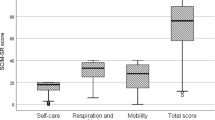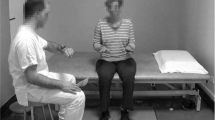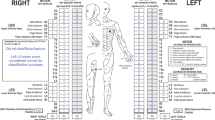Abstract
Study design:
Cross-sectional study using a consecutive sample.
Objectives:
To modify the Motor Assessment Scale (MAS) item 3 ‘balanced sitting’ and the Sitting Balance Score (SBS) to ensure suitability for patients with spinal cord injury (SCI), and to assess the inter-rater reliability and validity of these instruments.
Setting:
Spinal Care Unit, clinical setting.
Methods:
Unsupported sitting was tested by three physiotherapists using MAS and SBS in 48 in-patients with SCI. The validity of the scales was tested using neurological level and extent of injury according to the International Standards for Neurological Classification of Spinal Cord Injury, time since injury and the patients’ function, as measured by Functional Independence Measure (FIM) item 9–13 and Five Additional Mobility and Locomotor Items (5AML).
Results:
The inter-rater reliability was for MAS (kw=0.83–0.91) and for SBS (kw=0.69–0.96). The correlation between the balance scales were in relation to; neurological injury level (rs=0.19–0.51), extent of injury (rs=0.57–0.68) and the functional tests as measured by FIM items 9–13 (rs=0.13–0.68, highest for going up and down stairs) and 5AML (rs=0.10–0.49). The spread of data on the scales was poor.
Conclusion:
The inter-rater reliability of MAS and SBS was very good. The validity was little to moderate, probably because the chosen functional tests measured complex functional tasks and not only unsupported sitting. Both tests appear to be feasible in clinical settings, but will need major revisions. These results can therefore be used as a base for constructing new, better tests of unsupported sitting.
Similar content being viewed by others
Log in or create a free account to read this content
Gain free access to this article, as well as selected content from this journal and more on nature.com
or
References
Pollok A, Durward BR, Rowe PJ, Paul JP . What is balance? Clin Rehabil 2000; 14: 402–406.
Shumway-Cook A, Woollacott MH . Motor Control. Translating Research into Clinical Practice, 3rd edn. Lippincott Williams and Wilkins: Baltimore, MD, 2007.
Masur H, Papke K, Althoff S, Oberwittler C . Scales and Scores in Neurology Quantification of Neurological Deficits in Research and Practice. Thieme: Stuttgart, 2004.
Finch E, Brooks D, Stratford PW, Mayo NA . Physical rehabilitation outcome measures. A guide to enhanced clinical decision making. The Canadian Physiotherapy Association Health Outcomes. BC Decker Inc., 2002.
Duncan PW, Weiner DK, Chandler J, Studenski S . Functional reach. A new clinical measure of balance. J Gerontol 1990; 45: 192–197.
Lynch SM, Leahy P, Barker SP . Reliability of measurements obtained with a modified functional reach test in subjects with spinal cord injury. Phys Ther 1998; 78: 128–133.
Bolin I, Bodin P, Kreuter M . Sitting position—posture and performance in C5-C6 tetraplegia. Spinal Cord 2000; 38: 425–434.
Maynard Jr F, Bracken M, Creasey G, Ditunno JF, Donovan WH, Ducker T et al. International standards for neurological and functional classification of spinal cord injury. Spinal Cord 1997; 35: 266–274.
Norman GF, Streiner DL . Biostatistics. The Bare Essentials, 2nd edn. BC Decker Inc.: Ontario, 2000.
Carr J, Shepard RB, Nordholm L, Lynne D . Investigation of a new motor assessment scale for stroke patients. Phys Ther 1985; 65: 175–180.
Sandin KJ, Smith B . The measure of balance in sitting in stroke rehabilitation prognosis. Stroke 1990; 21: 82–86.
Lowen C, Anderson BA . Reliability of the modified motor assessment scale and barthel index. Phys Ther 1988; 68: 1077–1081.
Kjendahl A, Jahnsen R, Aamodt G . Motor assessment scale in Norway: translation and inter-rater reliability. Adv Physiother 2005; 7: 7–12.
Ota T, Akaboshi K, Nagata M, Sonoda S, Domen K, Seki M, Chino N . Functional assessment of patients with spinal cord injury: measured by the motor score and the Functional Independence Measure. Spinal Cord 1996; 34: 531–535.
Middleton JW, Harvey LA, Batty J, Cameron I, Quirk R, Winstanley J . Five additional mobility and locomotor items to improve responsiveness of the FIM in wheelchair dependent individuals with spinal cord injury. Spinal Cord 2006; 44: 495–504.
Sim J, Wright CC . The kappa statistics in reliability studies: use, interpretation, and sample size requirements. Phys Ther 2010; 85: 257–268.
Domholdt E . Rehabilitation Research. Principles and Applications, 3rd edn. Elsevier Saunders, 2005.
Chen C-L, Yeung K-T, Bih L-I, Wang C-H, Chen M-I, Chien J-C . The relationship between sitting balance and functional performance in patients with paraplegia. Arch Phys Med Rehabil 2003; 84: 1276–1281.
Boswell-Ruys CL, Sturnieks DL, Harvey LA, Sherrington C, Middleton JW, Lord SR . Validity and reliability of assessment tools for measuring unsupported sitting in people with a spinal cord injury. Arch Phys Med Rehabil 2009; 90: 1571–1577.
Field-Fote EC, Ray SS . Seated reach distance and trunk excursion accurately reflect dynamic postural control in individuals with motor-incomplete spinal cord injury. Spinal Cord 2010; 48: 745–749
Acknowledgements
We acknowledge financial support from Oslo University College, Faculty of Health Sciences. We thank the patients, students and the physiotherapists on the spinal unit at Sunnaas Rehabilitation Hospital for their participation in and contribution to this study.
Author information
Authors and Affiliations
Corresponding author
Ethics declarations
Competing interests
The authors declare no conflict of interest.
Rights and permissions
About this article
Cite this article
Jørgensen, V., Elfving, B. & Opheim, A. Assessment of unsupported sitting in patients with spinal cord injury. Spinal Cord 49, 838–843 (2011). https://doi.org/10.1038/sc.2011.9
Received:
Revised:
Accepted:
Published:
Issue date:
DOI: https://doi.org/10.1038/sc.2011.9
Keywords
This article is cited by
-
Quantifying unsupported sitting posture impairments in humans with cervical spinal cord injury using a head-mounted IMU sensor
Spinal Cord (2024)
-
Development and validation of the sitting balance assessment for spinal cord injury (SitBASCI)
Spinal Cord (2022)
-
Test-retest reliability and validity of the Sitting Balance Measure-Korean in individuals with incomplete spinal cord injury
Spinal Cord (2022)
-
Reliability and minimal detectable change of the Trunk Assessment Scale for Spinal Cord Injury (TASS) and the trunk control test for individuals with spinal cord injury
Spinal Cord Series and Cases (2022)
-
Adherence to and impact of home-based high-intensity IMT in people with spinal cord injury: a pilot study
Spinal Cord Series and Cases (2022)



